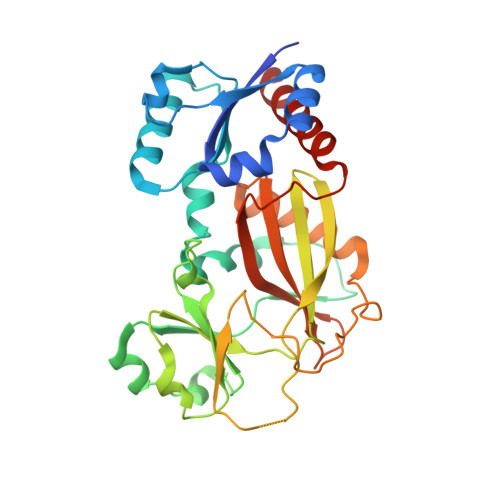Crystal Structure and Enzymology of Solanum tuberosum Inositol Tris/Tetrakisphosphate Kinase 1 ( St ITPK1).
Whitfield, H.L., Rodriguez, R.F., Shipton, M.L., Li, A.W.H., Riley, A.M., Potter, B.V.L., Hemmings, A.M., Brearley, C.A.(2024) Biochemistry 63: 42-52
- PubMed: 38146842
- DOI: https://doi.org/10.1021/acs.biochem.3c00404
- Primary Citation of Related Structures:
8OXE - PubMed Abstract:
Inositol phosphates and their pyrophosphorylated derivatives are responsive to the phosphate supply and are agents of phosphate homeostasis and other aspects of physiology. It seems likely that the enzymes that interconvert these signals work against the prevailing milieu of mixed populations of competing substrates and products. The synthesis of inositol pyrophosphates is mediated in plants by two classes of ATP-grasp fold kinase: PPIP5 kinases, known as VIH, and members of the inositol tris/tetrakisphosphate kinase (ITPK) family, specifically ITPK1/2. A molecular explanation of the contribution of ITPK1/2 to inositol pyrophosphate synthesis and turnover in plants is incomplete: the absence of nucleotide in published crystal structures limits the explanation of phosphotransfer reactions, and little is known of the affinity of potential substrates and competitors for ITPK1. Herein, we describe a complex of ADP and St ITPK1 at 2.26 Å resolution and use a simple fluorescence polarization approach to compare the affinity of binding of diverse inositol phosphates, inositol pyrophosphates, and analogues. By simple HPLC, we reveal the novel catalytic capability of ITPK1 for different inositol pyrophosphates and show Ins(3,4,5,6)P 4 to be a potent inhibitor of the inositol pyrophosphate-synthesizing activity of ITPK1. We further describe the exquisite specificity of ITPK1 for the myo -isomer among naturally occurring inositol hexakisphosphates.
Organizational Affiliation:
School of Biological Sciences, University of East Anglia, Norwich Research Park, Norwich NR4 7TJ, U.K.
















